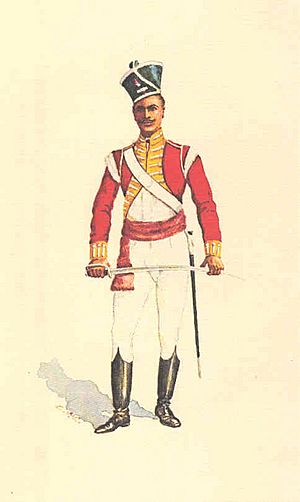Presidency armies facts for kids
Quick facts for kids Presidency armies |
|
|---|---|
 |
|
| Active | 1774–1895 |
| Country | India |
| Allegiance | East India Company |
| Branch | Army |
| Headquarters | GHQ India |
| Motto(s) | Auspicio Regis et Senatus Angliae "By command of the King and Parliament of England" |
| Mascot(s) | |
| Engagements | Battle of Plassey Battle of Buxar Carnatic Wars Anglo-Mysore Wars Anglo-Maratha Wars Vellore Mutiny Anglo-Nepalese War Anglo-Burmese wars First Anglo-Afghan War Anglo-Sikh wars Anglo-Persian War Indian Rebellion of 1857 |
| Commanders | |
| Notable commanders |
Stringer Lawrence Eyre Coote Robert Clive Charles Napier Charles Cornwallis Arthur Wellesley Archibald Campbell Gerard Lake James Outram Hugh Gough |

The presidency armies were special armies in British India. They belonged to the East India Company, a powerful British trading company. These armies were linked to the three main areas, or 'presidencies', that the Company controlled in India.
After the Indian Rebellion of 1857, the British government took over India. The presidency armies then became part of the new British Indian Army.
The three main presidency armies were:
- The Bengal Army
- The Madras Army
- The Bombay Army
Contents
How the Armies Started
In the mid-1700s, the East India Company began to build its own armies. They set up these armies in their three main cities in India. These cities were Calcutta (in Bengal), Madras, and Bombay.
Different Kinds of Regiments
Each of these three armies was a bit different. They had their own groups of soldiers, called regiments. Each army also had its own European officers.
The armies had two main types of regiments:
- European regiments: In these groups, both the officers and the regular soldiers were from Europe.
- Native regiments: These groups had European officers, but the regular soldiers were Indian.
Help from the British Government
Around the same time, the British government also started sending its own soldiers to India. These soldiers were part of the regular British Army. They were sent to help the East India Company's armies. People often called these troops 'H.M.'s Regiments' or 'Royal regiments'.
Changes After the 1857 Rebellion
The Indian Rebellion of 1857 was a major event. After it ended in 1858, big changes happened. The East India Company was no longer in charge of India.
Joining the British Army
In 1860, the European regiments of the Company's armies joined the regular British Army. However, the 'Native' regiments did not join. The three separate presidency armies kept going. Their European officers were still listed as part of the Bengal, Madras, or Bombay Army. But people started calling these combined armies the 'Indian Army'.
New Rules for Artillery
Another important change after the rebellion was about artillery. Artillery means large guns, like cannons. After 1857, only the British Army was allowed to use artillery. Indian troops were not allowed to use these powerful weapons.
Forming the Indian Army
Finally, in the 1890s, the separate Bengal, Madras, and Bombay armies were officially combined. They became one large army, known as the Indian Army.
Other Pages to Explore

